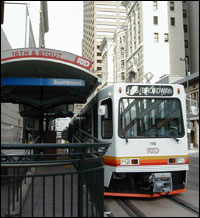Denver's Light Rail Experiment
by Michael Khoo
February 17, 2000
Governor Jesse Venture is in Denver, Colorado to tour that city's light-rail transit system. The trip is part of the governor's campaign to bring LRT to the Twin Cities, where the plan faces renewed opposition from some state lawmakers.
IT'S AFTERNOON RUSH HOUR on the corner of 16th and Stout in downtown Denver. Every five minutes or so, a boxy, white electric train cozies up to the curb to pick up office workers headed south to their homes. Passenger Ed Hier makes the round-trip every day.
Scott Reed is the spokesman for the Denver Area Regional Transportation District which oversees the LRT development. He says the expanding rail network is surpassing all expectations.
And as in Minnesota, so too in Colorado. The most
visible critic of Denver's LRT expansion has been Jon Caldara. In 1997, while he was chairman of of the RTD, Caldera
turned voters against an expansive transit proposal called "Guide the Ride."
In doing so, he effectively killed his own agency's initiative. Caldara is
now president of the Independence Institute, a self-described free-market
think tank.
Caldara says the best transit solutions are based on rubber, not steel, wheels.
Professor Andrew Goetz says that may be true, particularly when analyzing the system's early years. Goetz is the associate director of the Intermodal Transportation Institute at the University of Denver. He says it may take until the next wave of rail lines are up and running before making a final verdict on Denver's LRT.
by Michael Khoo
February 17, 2000
|
|
RealAudio 3.0 |
Governor Jesse Venture is in Denver, Colorado to tour that city's light-rail transit system. The trip is part of the governor's campaign to bring LRT to the Twin Cities, where the plan faces renewed opposition from some state lawmakers.
| |
|
|
|
||
IT'S AFTERNOON RUSH HOUR on the corner of 16th and Stout in downtown Denver. Every five minutes or so, a boxy, white electric train cozies up to the curb to pick up office workers headed south to their homes. Passenger Ed Hier makes the round-trip every day.
Hier: Right now it goes to the Broadway park and ride. So I park there and ride it in to here every morning - fairly early. You have to get there very early to get a parking spot. That's one of the drawbacks at the present time.So popular, in fact, that official estimates place Denver's rail ridership at more than 16,000 each weekday, about 20 percent ahead of projections. To date, Denver has only one LRT line. It runs through the city's central business corridor, a relatively modest five miles. But an extension set to open this summer will add another nine miles of rail service to the southwestern suburbs. And last November, metro-area voters approved an ambitious 19-mile line which will serve the Denver metro's booming southeastern neighborhoods.
MPR: It's popular then?
Hier: Very. Yeah, actually, there's a lot of people standing, actually, in the train.
Scott Reed is the spokesman for the Denver Area Regional Transportation District which oversees the LRT development. He says the expanding rail network is surpassing all expectations.
Reed: In terms of evaluating the success of light rail, in terms of ridership, in terms of reducing the number of single-occupant trips, in terms of increases in ridership on the bus feeder system, it actually is cheaper to carry a passenger by light rail than it is to carry a passenger by bus. All of those categories, we have exceeded our projections.But not everyone believes LRT makes the best use of public dollars. A fight against Minneapolis' proposed Hiawatha line is percolating in the Minnesota House of Representatives. The Republican majority wants to repeal nearly $100 million in state bonding authority currently earmarked for the $548 million project. Opponents say the money could be better spent on improved bus service.
|
"It hasn't taken traffic off the roads. People aren't getting out of their cars to get on the choo-choo train."
- Jon Caldara |
Caldara says the best transit solutions are based on rubber, not steel, wheels.
Caldara: The fact of the matter is that it hasn't taken traffic off the roads. People aren't getting out of their cars to get on the choo-choo train. It just does not happen because, unlike a bus system, unlike anything with rubber tires, your train cannot deviate.Caldara says a system of buses, for-profit car pools, and toll lanes would encourage efficient freeway use at a fraction of light rail's cost. Caldara says Denver's rail line appears successful only because the RTD cut downtown bus service, forcing bus riders onto the train.
Professor Andrew Goetz says that may be true, particularly when analyzing the system's early years. Goetz is the associate director of the Intermodal Transportation Institute at the University of Denver. He says it may take until the next wave of rail lines are up and running before making a final verdict on Denver's LRT.
Goetz: And then, of course, in 2007 we will have this southeast corridor. That's really going to be the one I think that's going to tell the story of whether or not light rail is going to be successful or not here in Denver. So I think we're looking at another 10 years before we have the answer to that question.Governor Ventura, of course, doesn't have 10 years to wait for an answer. Instead, he'll tour Denver's central corridor line as well as the expansion projects in the southwest and southeast.

